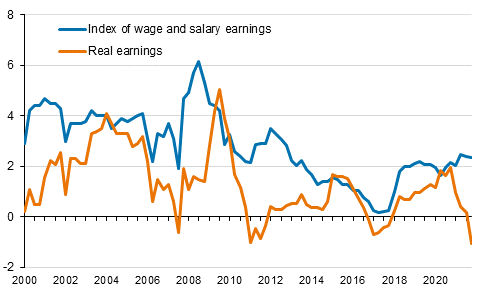Published: 4 February 2022
Wage and salary earners’ real earnings decreased by 1.1 per cent in October-December
According to Statistics Finland’s preliminary data, the index of wage and salary earnings, which measures the rise in the nominal earnings of full-time wage and salary earners, rose by 2.3 per cent in October to December 2021 when compared with the respective period in 2020. Real earnings decreased by 1,1 per cent compared to the fourth quarter of the previous year because the rise in consumer prices was faster than that in earnings level.
Index of wage and salary earnings and real earnings 2000/1 to 2021/4, annual change percentage

According to Statistics Finland’s preliminary data, the nominal earnings of full-time wage and salary earners rose from October to December 2020 to the corresponding period in 2021 by 2.4 per cent in the private sector, by 2.3 per cent in the central government sector and by 2.1 per cent in the local government sector.
Compared to the year before, the average increase in the level of earnings during 2021 was 2.3 per cent, whereas the increase in real earnings was 0.1 per cent according to preliminary data.
The development of real earnings started to decline in the last quarter of 2021. On a quarterly basis, real earnings had been growing steadily since the beginning of 2018. The 1.1 per cent decline in the fourth quarter of 2021 is the largest quarter-on-quarter decline in real earnings in the 21st century. The largest decline before that was 1.0 per cent in the first quarter of 2011. Due to the negative development towards the end of the year, the development of real earnings averaged almost zero in 2021 according to preliminary data.
The index of regular earnings increased by 2.3 per cent in October to December
The index for regular earnings describes the permanent change in earnings better than the index of wage and salary earnings because it does not take into account performance-based bonuses and non-recurring items included in collective agreements. The index of regular earnings rose by 2.3 per cent in October to December 2021 when compared with the respective period in 2020. The growth amounted to 2.4 per cent in the private sector, to 2.3 per cent in the central government sector, and to 2.1 per cent in the local government sector. The relative change in the index of regular earnings differed only marginally from the relative change in the index of wage and salary earnings in the fourth quarter of 2021.
Index of wage and salary earnings and index of regular earnings are final as far as the year 2020
The indices of wage and salary earnings and the indices for regular earnings are final until 2020. They are based on the realised earnings development. The indices for 2021 are preliminary and they are based on estimates of agreement effects and the wage drift. In addition, the data on performance-based bonuses of the Labour Cost Index are used to assess performance-based bonuses in the calculation of the preliminary indices of the index of wage and salary earnings.
Source: Index of wage and salary earnings 2021, 4th quarter. Statistics Finland
Inquiries: Jukka Tapio 029 551 3429, Harri Nummila 029 551 3235, palkat.indeksit@stat.fi
Head of Department in charge: Hannele Orjala
Publication in pdf-format (444.4 kB)
- Tables
-
Tables in databases
Pick the data you need into tables, view the data as graphs, or download the data for your use.
Appendix tables
- Appendix table 1. Index of wage and salary earnings 2015=100 by employer sector and base of payment (4.2.2022)
- Appendix table 2. Index of regular earnings 2015=100 by employer sector and base of payment (4.2.2022)
- Appendix table 3. Index of wage and salary earnings 2015=100 by employer sector and gender (4.2.2022)
- Appendix table 4. Index of regular earnings 2015=100 by employer sector and gender (4.2.2022)
- Appendix table 5. Index of wage and salary earnings 2015=100 by industry (TOL 2008) (4.2.2022)
- Appendix table 6. Index of regular earnings 2015=100 by industry (TOL 2008) (4.2.2022)
- Appendix table 7. Index of wage and salary earnings 2010=100 by employer sector and gender (4.2.2022)
- Appendix table 8. Index of wage and salary earnings 2010=100 by industry (TOL 2008) (4.2.2022)
- Appendix table 9. Index of wage and salary earnings 2015=100, percentage changes (4.2.2022)
- Appendix table 10. Index of regular earnings 2015=100, percentage changes (4.2.2022)
- Appendix table 11. Average earnings by employer sector and gender, EUR/month (4.2.2022)
- Revisions in these statistics
-
- Revisions in these statistics (4.2.2022)
Updated 4.2.2022
Official Statistics of Finland (OSF):
Index of wage and salary earnings [e-publication].
ISSN=1798-7814. 4th quarter 2021. Helsinki: Statistics Finland [referred: 25.12.2025].
Access method: http://stat.fi/til/ati/2021/04/ati_2021_04_2022-02-04_tie_001_en.html

